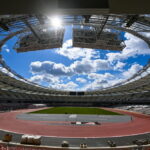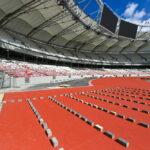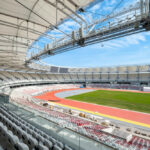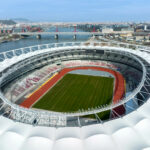The National Athletics Center was completed by the deadline, and the home of the Athletics WC will be handed over soon. After the World Cup, the complex will continue to operate as a freely accessible sports and leisure park.
By the end of March 2023, the National Athletics Center (NAK), which will host the 2023 World Athletics Championships, reached its most significant milestone: on March 1, 2023, the specialists of the consortium formed by the general contractor ZÁÉV Zrt. and Magyar Építő Zrt. began the technical handover of the project magyarepitok.hu reports based on the information received from the consortium.
Technical curiosities
The stadium building
- for the structural construction work, from the foundation to the piling works, nearly 100,000 cubic meters of earth were excavated,
- for the pile foundation, 1,200 tons of reinforcing steel and approximately 13,000 cubic meters of concrete were used,
- while for the acquisition, 4,300 tons of reinforcing steel and approximately 40,000 cubic meters of concrete were used together with the beam gratings and head blocks,
- 48 roof structural elements, each weighing 100 tons, form the "crown" of the building.
After the World Cup, the complex will continue to operate as a freely accessible sports and leisure park
The sports center will welcome sports lovers with more than 35,000 seats for the World Cup, after which this number will decrease to 15,000 - including the surrounding infrastructure. However, the implementation of the investment will not only be about the nine days of the Budapest Athletics World Cup:
In addition to the fact that the facility will be a prominent competition venue and training center for Hungarian athletics, the additional result of the project will be the creation of the newest green sports and leisure center in Budapest, where not only competitive athletes but also the general public will have access to leisure sports and recreation opportunities.
The park surrounding the stadium includes a green area of about 50,000 square meters, planted with hundreds of trees and nearly 18,000 shrubs, which will eventually become as popular a location as other areas of the capital serving a similar purpose, such as Normafa or Margitsziget.
Cover photo: Magyar Építő Zrt.
- Photo: MTI/Tibor Illyés
- MTI/Tibor Illyés
- Photo: Magyar Építő Zrt.
- Photo: Magyar Építő Zrt.
















